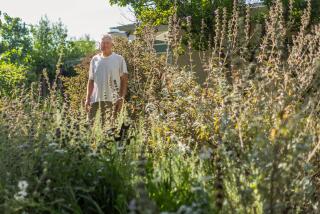Topic: Tropics
- Share via
There is, among Southern Californians, a common misconception that we live in some kind of tropical desert when, in fact, we are neither desert nor tropics. Admittedly, we can grow cactus and bananas, and local gardeners have fun making their “tropical” or “desert” statements.
But the actual name for our climate is “Mediterranean” or “summer-dry subtropical.” The true desert is just over the mountains and beyond the Colorado River. And the true tropics are found in places such as southern Mexico, Hawaii or exotic Bali.
Still, a conversation with a tropical landscape designer based in Indonesia offers some valuable nuggets for those entranced by the lush landscapes of more southern climes.
Tropical landscapes, said Made Wijaya, in town recently from Bali, are dependent on man-made structures and introduced color, and on foliage shapes and textures. Born in Australia, and the author of “Tropical Garden Design” (Tuttle, $50, to be published this spring), Wijaya knows climates like ours well enough to compare the true tropics with the wannabes.
In the tropics, he said, “you have to be more imaginative with the choice of leaf shapes because there are so many similar greens,” and he pointed out that there are entire seasons when blooms of any kind are scarce.
The biggest difference between Mediterranean and tropical climates has to do with plant growth rates. In the tropics, he said, “designs can quickly decompose and be overwhelmed by growth.”
Wijaya recalls the shocked looks on the faces of some English tourists as they watched him and a crew, armed with machetes and chain saws, slashing their way through a Bali hotel garden “like crazed commandos,” trying to restore order.
“People who are born in tropical climates are less enamored of leafy fecundity,” he said. “You have to be quite ruthless in a tropical climate.”
Yet his tropical designs look anything but ruthless. From photographs in his book, one can see they are lush with foliage and some flowers, deftly contrasted against walls, water, garden art and other man-made contrivances. Wijaya suggests that this distinctive look comes from the Asian influence found in Bali.
“These are Asian tropical gardens, and the whole culture in Bali is based on nature and the concept of the spirit of the place. When you think about gardens in Asia, you think of mountains and water,” he said, and one of the most noticeable aspects of his gardens is the overwhelming presence of water, mostly in quiet, reflective ponds that occupy far more space than would be considered desirable here.
One of his favorite plants is the lotus, a water plant, but he is also fond of palms, especially coconut palms, “for their grace and the spring of their fronds.” He loves muscular banyan trees, “the Jesse Ventura of the plant world,” as well as bougainvillea, plumeria, crinums, heliconias and bamboos--the traditional stuff of tropical gardens.
But his gardens are anything but traditional.
“I’m considered a bit of a rogue in Bali,” Wijaya told me, and his gardens are truly original. Though tropical gardens from around the equatorial world are pictured, the most wonderful are Wijaya’s Asian gardens, particularly those on his home island of Bali.
Wijaya is a landscape architect by profession and was trained as an architect, but, he says, “I think of myself as a gardener.” He left architecture school after three years in Australia and moved to Bali to work as a gardener for some friends and decided to pursue landscape design after that.
His most innovative designs confine the superabundance of the jungle, the intricate elegance of Asian art, and lots of water, all inside glowing courtyards that could as easily be in Brentwood as Bali.
Robert Smaus can be reached at robert.smaus@latimes.com.






